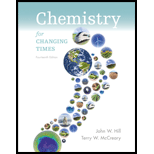
Concept explainers
(a)
Interpretation: Name of formula of compound (HCl) should be written.
Concept Introduction: The formula of compound identifies the atoms or ions present in it. The formula is formed by crisscross method, in which, charge on one ion goes into subscript of other and vice versa. In a compound, generally ion with positive charge is written same as the name of element for but ion with negative charge is written with suffix −ide. For example the name of NaOH is sodium hydroxide. Where, sodium is Na+ ion and chloride is Cl- ion.
(b)
Interpretation: Formula of name of compound (strontium hydroxide) should be written.
Concept Introduction: The formula of compound identifies the atoms or ions present in it. The formula is formed by crisscross method, in which, charge on one ion goes to subscript of other and vice versa. In a compound, generally ion with positive charge is written same as the name of element for but ion with negative charge is written with suffix −ide. For example the name of NaOH is sodium hydroxide. Where, sodium is Na+ ion and chloride is Cl- ion.
(c)
Interpretation: Name of formula of compound (KOH) should be written.
Concept Introduction: The formula of compound identifies the atoms or ions present in it. The formula is formed by crisscross method, in which, charge on one ion goes to subscript of other and vice versa. In a compound, generally ion with positive charge is written same as the name of element for but ion with negative charge is written with suffix −ide. For example the name of NaOH is sodium hydroxide. Where, sodium is Na+ ion and chloride is Cl- ion.
(d)
Interpretation: Formula of name of compound (boric acid) should be written.
Concept Introduction: The formula of compound identifies the atoms or ions present in it. The formula is formed by crisscross method, in which, charge on one ion goes to subscript of other and vice versa. In a compound, generally ion with positive charge is written same as the name of element for but ion with negative charge is written with suffix −ide. For example the name of NaOH is sodium hydroxide. Where, sodium is Na+ ion and chloride is Cl- ion.
Want to see the full answer?
Check out a sample textbook solution
Chapter 7 Solutions
Chemistry For Changing Times (14th Edition)
 ChemistryChemistryISBN:9781305957404Author:Steven S. Zumdahl, Susan A. Zumdahl, Donald J. DeCostePublisher:Cengage Learning
ChemistryChemistryISBN:9781305957404Author:Steven S. Zumdahl, Susan A. Zumdahl, Donald J. DeCostePublisher:Cengage Learning ChemistryChemistryISBN:9781259911156Author:Raymond Chang Dr., Jason Overby ProfessorPublisher:McGraw-Hill Education
ChemistryChemistryISBN:9781259911156Author:Raymond Chang Dr., Jason Overby ProfessorPublisher:McGraw-Hill Education Principles of Instrumental AnalysisChemistryISBN:9781305577213Author:Douglas A. Skoog, F. James Holler, Stanley R. CrouchPublisher:Cengage Learning
Principles of Instrumental AnalysisChemistryISBN:9781305577213Author:Douglas A. Skoog, F. James Holler, Stanley R. CrouchPublisher:Cengage Learning Organic ChemistryChemistryISBN:9780078021558Author:Janice Gorzynski Smith Dr.Publisher:McGraw-Hill Education
Organic ChemistryChemistryISBN:9780078021558Author:Janice Gorzynski Smith Dr.Publisher:McGraw-Hill Education Chemistry: Principles and ReactionsChemistryISBN:9781305079373Author:William L. Masterton, Cecile N. HurleyPublisher:Cengage Learning
Chemistry: Principles and ReactionsChemistryISBN:9781305079373Author:William L. Masterton, Cecile N. HurleyPublisher:Cengage Learning Elementary Principles of Chemical Processes, Bind...ChemistryISBN:9781118431221Author:Richard M. Felder, Ronald W. Rousseau, Lisa G. BullardPublisher:WILEY
Elementary Principles of Chemical Processes, Bind...ChemistryISBN:9781118431221Author:Richard M. Felder, Ronald W. Rousseau, Lisa G. BullardPublisher:WILEY





